A Study on Establishing a Crossborder E-commerce Logistics System for Agricultural Products in Sichuan Province in the Context of the Belt and Road Initiative
You Jing
Chengdu University
Chen Haonan*
National Institute of Development Administration
Abstract: The rapid development of cross-border e-commerce, especially since Chengdu was listed as an Integrated Pilot Zone for Cross-Border E-Commerce in 2016, has led to a rising trade value of agricultural products in the metropolis. This upward trend is also attributed to the China-Europe Railway Express and the Chengdu International Aviation Hub Integrated Functional Area, two infrastructure systems that have opened more international logistics channels for agricultural products in Sichuan province. However, the development of crossborder logistics has failed to respond to the rapid growth of cross-border e-commerce for agricultural products.This problem has given rise to longer delivery cycles, higher costs, and reduced product quality, hindering the development of cross-border e-commerce for agricultural products. Currently, most research efforts are focused on selecting a logistics mode which has created an urgency is to establish a logistics system. To that end, we must utilize the opportunities and preferential policies brought about by the Belt and Road Initiative to advance the establishment of a cross-border logistics system for agricultural products, which will create more channels for selling Sichuan’s agricultural products overseas. This article analyzes the current situation of the cross-border logistics system for agricultural products produced by the province and studies the potential relationships between a logistics system and cross-border trade of agricultural products. It seeks to build a logistics system that meets the demands of cross-border transactions using economic theories focused on cross-border e-commerce and logistics.Such a logistic system will help shorten long delivery cycles, cut delivery costs, and guarantee the quality of agricultural products. Also, it can contribute to the rapid development of cross-border e-commerce of agricultural products and solve problems in developing the agricultural products logistics system of Sichuan province.
Keywords: the Belt and Road Initiative, agricultural products, cross-border e-commerce, logistics system
Background and Significance of the Study
On January 6, 2016, Chengdu was approved as an Integrated Pilot Zone for Cross-Border E-Commerce featuring three elements including “Base Station,” “Power,” and “Relay.” By building logistics infrastructures and following trade rules, the Zone aimed to forge partnerships with countries along the Silk Road on a case-specific basis, providing solid policy support and guarantees for cross-border transactions of agricultural products. At the beginning of 2017, the State Council of the People’s Republic of China proposed a strategic plan to designate and build functional areas for grain production and protected areas to produce important agricultural products in an attempt to offer a sufficient source of agricultural products in Sichuan’s efforts to export agricultural products.In August 2019, the General Office of the State Council of the People’s Republic of China issued the Opinions of the General Office of the State Council on Accelerating the Development of Circulation Industry and Promoting Consumer Spending, which focused on accelerating the circulation of agricultural products and stepping up improvements of the producer markets for agricultural products.In particular, the document specified that it would be necessary to accelerate the development of cold chain logistics for agricultural products, improve the agricultural product circulation system, and step up the support for integrated “collection and delivery facilities” for sorting, processing, packaging,and pre-cooling agricultural products. Infrastructure should also be strengthened in characteristic agricultural production areas to modernize the agricultural industry. This will broaden the online and offline sales channels, expand channels for foreign trade and drive up the consumption of agricultural products while increasing output.
Currently, there is a mismatch between the rapid growth of cross-border e-commerce and the inadequate development of cross-border logistics systems, giving rise to a host of setbacks. The crossborder trade of agricultural products is being impeded by lengthy delivery times and high delivery prices. These impediments mean that we need to build and optimize a complete agricultural product logistics system that can meet the needs of the ever-growing cross-border trade industry. For example,the China Railway Express and the Chengdu International Aviation Hub Integrated Functional Area can accelerate our efforts to open more international logistics channels for Sichuan’s agricultural products. Studies on the cross-border logistics system of Sichuan’s agricultural products have made significant contributions to making Sichuan an important hub for cross-border trade and exchanges with countries along the Belt and Road.
Research Status and Potential Innovations
There are now only a few domestic studies dedicated to the establishment of logistics systems in China, and most scholars are, in fact, choosing among many logistics models. Since cross-border e-commerce logistics systems for agricultural products in China are still relatively underdeveloped,the logistics for agricultural products remains a major problem. Due to the lack of theoretical study and practical experience in this regard, underdeveloped logistics have been hindering the export of agricultural products.
Status of Foreign Studies
As a broad concept, the cross-border logistics systems for agricultural products are a combination of various subsystems that cover procedures ranging from production to the sales of agricultural products. There is now a lack of comprehensive and systematic foreign studies on agricultural product logistics, as current studies are only focused on single aspects, such as model selection or cost reduction. Roh Kyung Ho (2008) successfully reduced logistics costs through efficiently operating of the export logistics system for fresh agricultural products, including collection, unloading, sorting,packaging, customs declarations, and integrated logistics services of agricultural products. Using the TIST model, Andrew Higgins (2015) studied investments in infrastructure construction, reaching the conclusion that increased investments in building infrastructures, coupled with policy changes, may significantly reduce costs.
Status of Domestic Studies
This article aims to analyze, integrate and use the currently available study results in one small aspect of the logistics system, such as cross-border e-commerce and logistics for agricultural products and the Belt and Road Initiative (BRI). There are few domestic studies on cross-border e-commerce logistics systems for agricultural products, as most domestic scholars focus on a specific logistics model or how to reduce logistics costs instead of conducting comprehensive studies. The lack of well-developed theories will hinder the development of cross-border logistics of agricultural products in Sichuan and hamper the agricultural economy of the province. Due to the rapid economic development, the local people also expect to enjoy a higher quality of life,increasing their demand for high-quality imported agricultural products. Xu Ran (2020) pointed out that cross-border e-commerce was a major driving force behind the development of foreign trade of agricultural products in recent years, thus exerting a profound influence on exports and stepping up the drive for globalization. Han Xuejin (2021) believed that cross-border e-commerce optimized the traditional foreign trade model so that foreign trade is no longer constrained by time and space, maximizing logistics efficiency. Wang Xiumei (2021) suggested that optimized product supply chains and network systems could improve the efficiency and economic benefits of logistics.Zhou Dao (2020) believed that logistics systems played a vital role in promoting foreign trade of agricultural products, providing a strong guarantee for cross-border e-commerce of products.Zhao Peirou (2021) maintained that the BRI had injected a new impetus into the foreign trade of agricultural products and beefed up the agricultural product industry structure. Han Xuejin (2021)argued that the BRI had led to closer international exchanges and provided important strategic support for the cross-border trade of agricultural products. Xu Hanzhu (2020) thought that the BRI was conducive to integrating favorable resources at home and abroad and creating new historical opportunities for the development of cross-border e-commerce and logistics.
Potential Innovations
Combining the BRI, cross-border e-commerce, and logistics system and focusing on the establishment of agricultural product logistics system, this article, considering the actual situation in Sichuan, compares and analyzes the studies of domestic and foreign scholars on agricultural product logistics. However, there have been few previous studies on comprehensive and systematic logistics systems. Most scholars are studying how to select logistics models and reduce logistics costs.
This article analyzes the logistics systems for agricultural products in Sichuan province and studies the establishment of cross-border e-commerce logistics systems for agricultural products against the backdrop of the BRI. Additionally, Chengdu, the capital city of Sichuan province, can qualify as a representative area for conducting analysis and studies in this regard. Establishing a cross-border e-commerce logistics system for Sichuan’s agricultural products can enable the province to be more competitive on the international stage. In-depth studies on this point will provide a solid theoretical framework for developing foreign trade of agricultural products. A completed logistics system plays a central role in turning Sichuan into an internal hub connecting the East and the West and bolstering domestic trade of agricultural products. Also, it is a contributing factor for conducting foreign trade and exchanges with cities along the Silk Road.
Current Situation of Cross-Border E-Commerce Logistics System for Agricultural Products in Sichuan Province in the Context of the Belt and Road Initiative
Sichuan is a major economic province in China and was ranked sixth among all Chinese provinces in terms of GDP in 2019. In 2020, the GDP of Sichuan Province reached RMB4,859,876 million, an increase of 3.8 percent over the previous year. Specifically, RMB5,556.658 billion came from the primary industries, a year-on-year increase of 5.2 percent; RMB1,757.111 billion was attributed to the secondary industries, a year-on-year increase of 3.8 percent; RMB2,547.107 billion was ascribed to the tertiary industries, a year-on-year increase of 3.4 percent. Both the GDP and per capita GDP of Sichuan province have been increasing at a stable rate, showing an overall upward economic trend.
Overview of the Import and Export of Agricultural Products in Sichuan Province
Sichuan, a large agricultural province with abundant favorable natural resources, including adequate water sources and desirable climate conditions, is perfectly suited for exporting large quantities of agricultural products. Its large population and sufficient labor force have laid the foundation for the production of agricultural products. All these favorable conditions have paved the way for the foreign trade of Sichuan’s agricultural products and increased the profit margins in Sichuan’s agricultural economy. The specific data is detailed in the following table.

Table 1 Export of Agricultural Products in Sichuan Province in the Past 5 Years Unit: 100 million yuan
To transport fresh agricultural products, we need to improve the logistics system to guarantee the quality and price of agricultural products. Thanks to its abundant resources and favorable climate conditions, Sichuan province can produce many types of vegetables and has developed a characteristic fruit industry. As can be seen from the table below, in the past five years, the output of vegetables and fruits in Sichuan province has seen an upward trend, indicating that the province is increasingly capable of supplying agricultural products. This has contributed to the development of agricultural product logistics in the province.

Table 2 Production of Vegetables and Fruits in Sichuan Province
Development of Cross-border E-commerce in Sichuan Province
Traditional industries have incurred huge losses in recent years. The advent of the big data era has prompted many foreign trade companies to consider shifting to the cross-border e-commerce industry. For example, from January to September 2018, according to the statistics of Chengdu Customs, the import and export value of cross-border e-commerce totaled RMB340 million, a ten times increase over the same period the previous year, suggesting that cross-border e-commerce is developing rapidly in Sichuan province. Moreover, Rongyihui, a cross-border e-commerce community, has been very effective in pooling resources and improving the communication of information.
The following table shows that major trade markets that are buying agricultural products from Sichuan include the Association of Southeast Asian Nations (ASEAN), the EU, the US. By analyzing these major trade markets and the trade values of the agricultural exports, we find that regions to which the products are exported and the quantity of products remained stable. Still, there was an imbalance in the trade values of different regions.
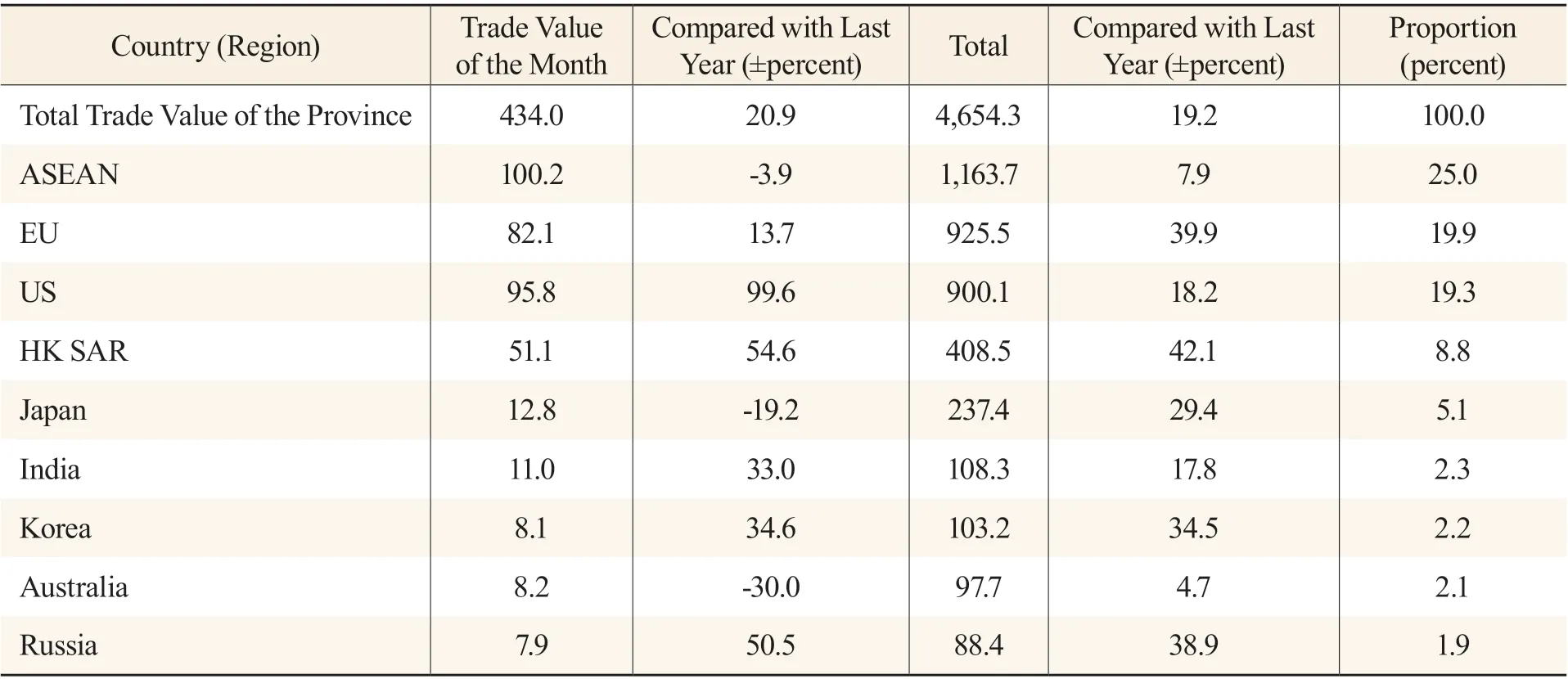
Table 3 Major Export Markets and Trade Values of Sichuan Province in 2020 Unit: 100 million yuan
As a quarter of Sichuan’s agricultural products have been exported to ASEAN countries, it is important to study the countries along the Belt and Road. For example, in 2020, the import and export value of goods between China and Thailand was US98,624.831 million, which was US687,243 million higher compared to 2019 and a year-on-year increase of 7.5 percent.
Logistics Overview and Analysis of Logistics for Agricultural Products of Sichuan Province
Currently, Sichuan province is equipped with relatively complete logistics infrastructures, and Chengdu Shuangliu International Airport has opened 110 international routes. As of now, Chengdu has built seven international railway channels and five rail-sea intermodal transport corridors and is home to the largest central railway container station in Asia. The China-Europe Railway Express is an important hub for conducting trade with countries participating in the BRI. Connecting 22 overseas cities and 14 domestic cities, it ranked first in China in terms of the number and time of operations for two consecutive years and played a vital role in the foreign trade of agricultural products of Sichuan province. Sichuan province has also built several airports and comprehensive bonded zones that exempt goods transported through water, air, and land from duties, and the logistics network system of Sichuan province is gradually developing into a comprehensive transportation model. Thanks to the BRI and various preferential measures, these factors will boost the rapid development of Sichuan’s cross-border e-commerce and logistics system and contribute to greater agricultural economic benefits for the province.
Chengdu, the capital city of Sichuan, is known as the land of abundance. The GDP of Chengdu accounted for a large proportion of the total GDP of Sichuan province in 2020. Therefore, Chengdu can reflect the foreign trade of agricultural products produced by Sichuan.
Chengdu covers a vast area of 12,390 square kilometers, including 7.832 million mu (or 1.29 million acres) of arable land, of which 352,000 mu (58,080 acres)is garden plots. The areas of arable land and garden plots in various districts of Chengdu are listed in Table 4. The structure of Chengdu’s agricultural products is given in Table 5. Chengdu farmers mainly plant grain crops,vegetables, oilseed rape, and potatoes, manufacture pork, poultry, eggs, and milk, and produce citrus fruits.
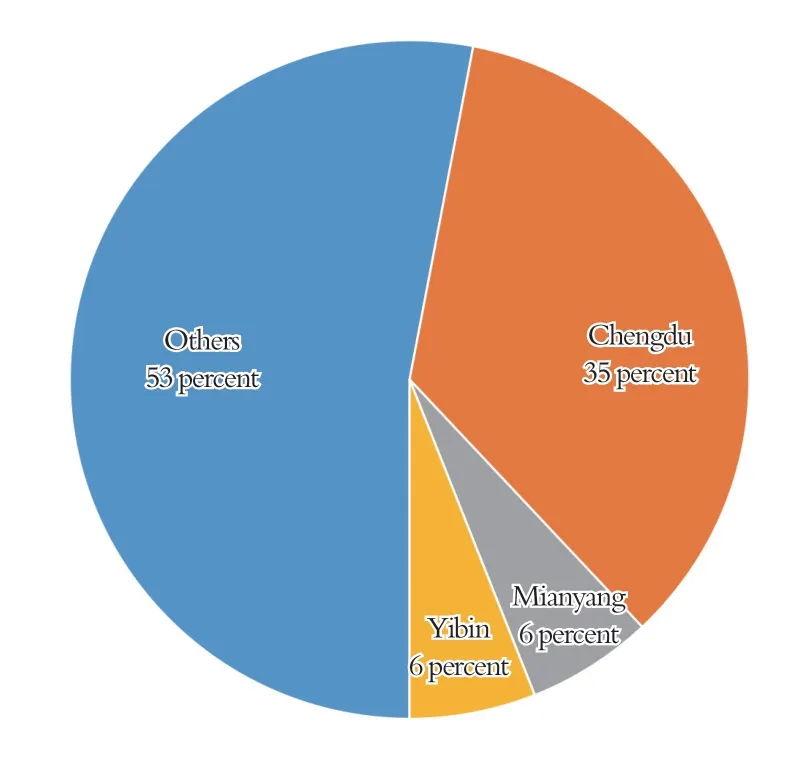
Figure 1: The Proportion of Chengdu’s GDP in Sichuan Province
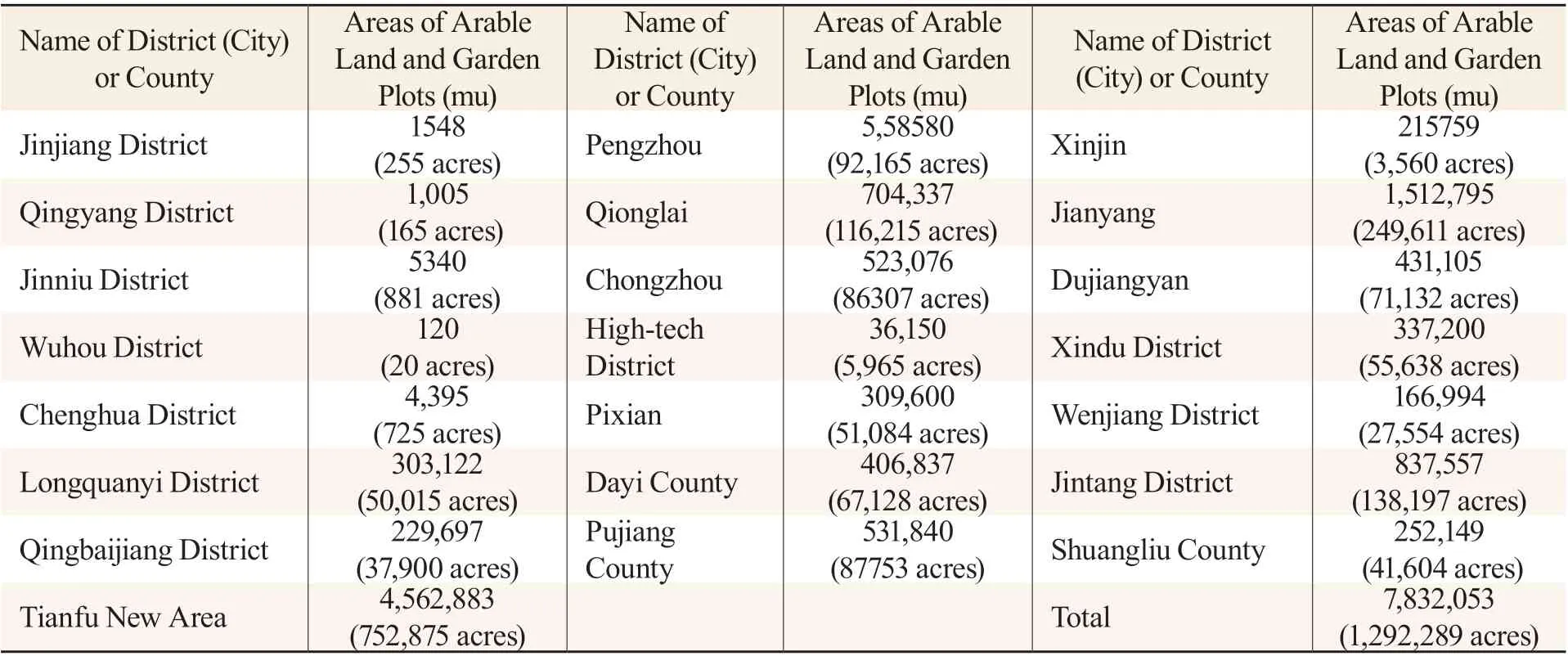
Table 4 Area of Arable Land in Each District of Chengdu

Table 5 Overview of Chengdu’s Agricultural Production in 2018
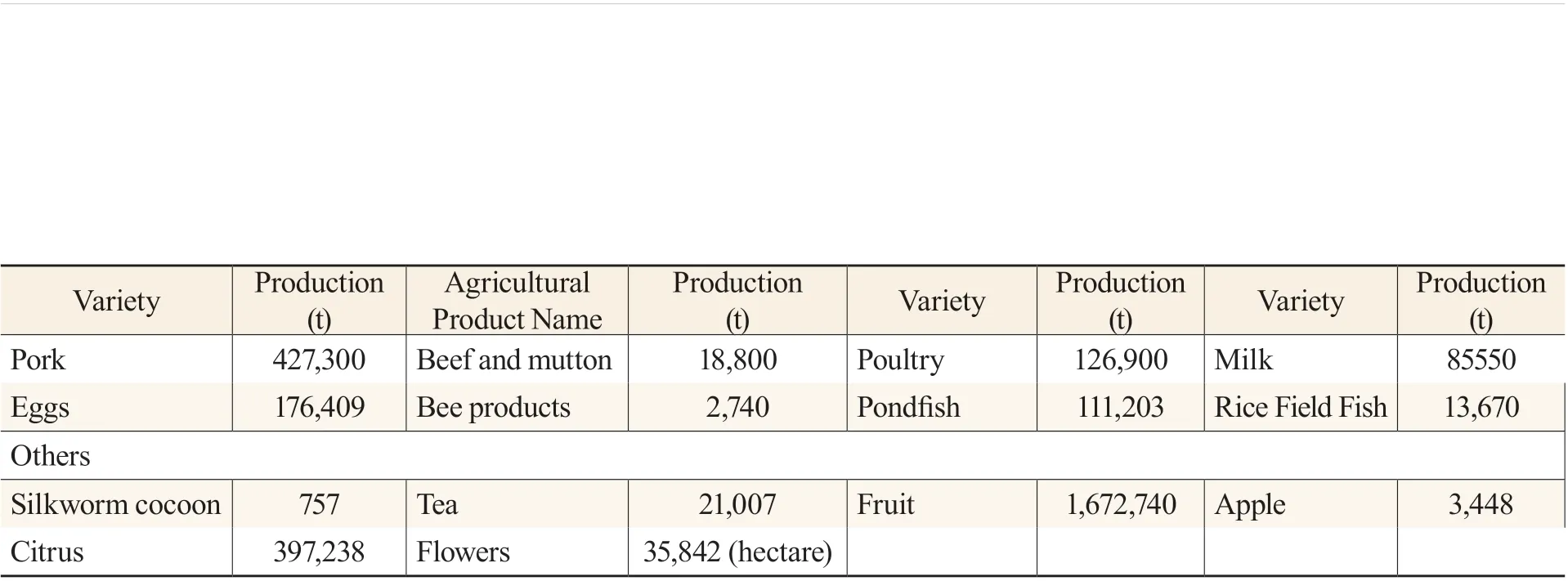
Source: Chengdu Statistical Yearbook
As indicated by the data in the table below, the freight volume of Chengdu has been on the rise,setting higher requirements for logistics.

Table 6 Freight Volume of Chengdu in the Past 5 Years

Table 7 Air and Road Transportation
On January 6, 2016, Chengdu was approved to establish an integrated pilot zone for crossborder e-commerce to promote cross-border trade in new ways. Since 2012, China has released several policies to boost the development of cross-border e-commerce. These policies have prompted gratifying achievements in cross-border e-commerce. Such favorable conditions for developing crossborder e-commerce will drive the upgrading of cross-border logistics systems. Sichuan will export its agricultural products by establishing a cross-border e-commerce platform and improving its crossborder logistics. Additionally, the BRI and the China Railway Express have provided significant historical opportunities and strategic basis for selling the agricultural products of Sichuan province to other countries. The advent of the “Internet +” Era and the Big Data Era will lead to a comprehensive upgrading of the cross-border logistics systems. We must seize this opportunity to efficiently integrate cross-border e-commerce and logistics systems to increase the export volume of agricultural products,ensure the quality of exports, and improve the agricultural economic benefits for the province comprehensively.
Although the logistics industry in Sichuan province has witnessed continuous improvement,overall, the industry is still underdeveloped. For this reason, we should give top priority to the improvement of logistics systems to stimulate the growth of agricultural products and improve the overall agricultural economic efficiency in Sichuan province.
SWOT Analysis of the Cross-border E-commerce Logistics System for Sichuan’s Agricultural Products
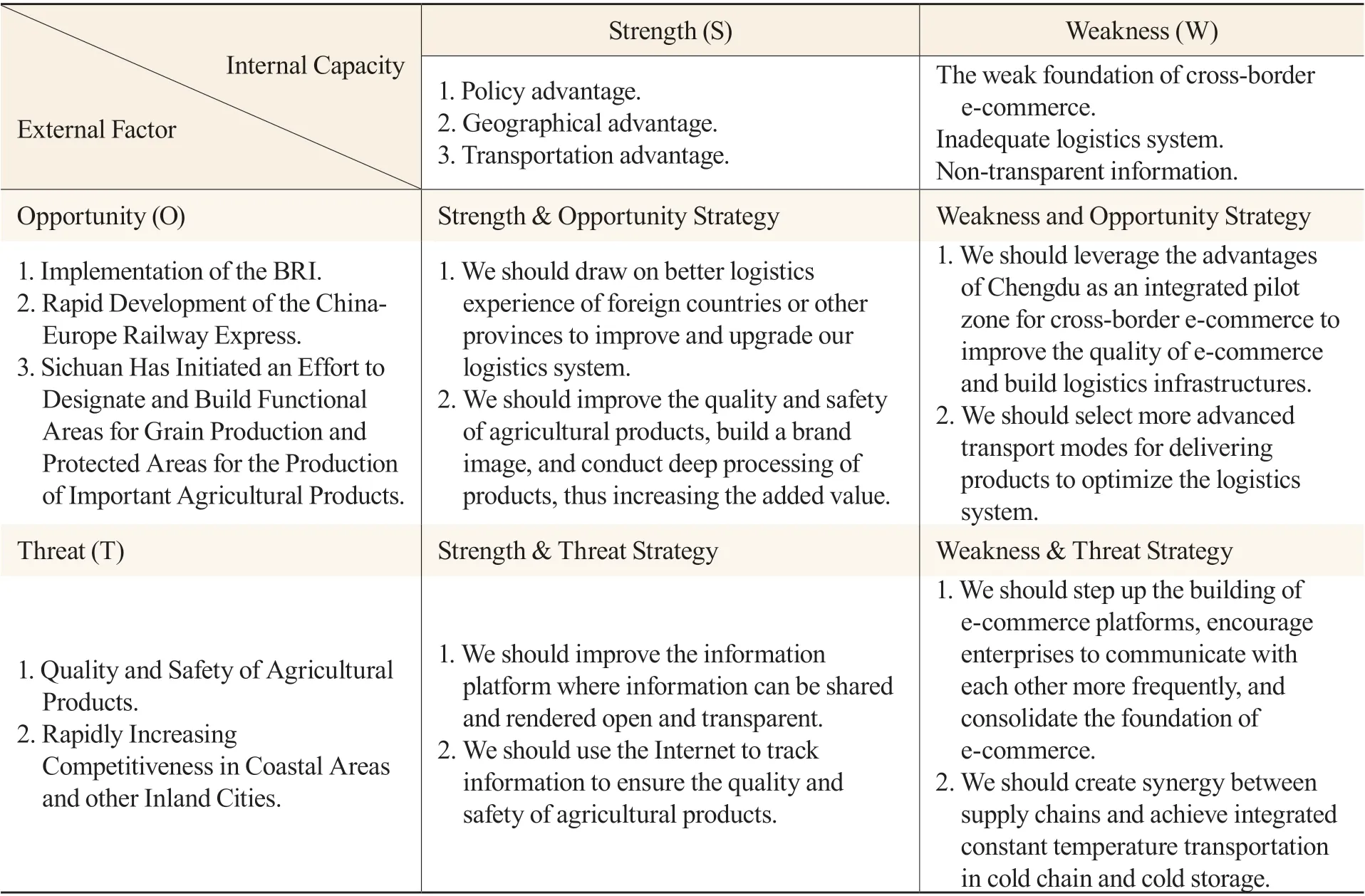
Table 8 SWOT Matrix Analysis
The cross-border logistics for agricultural products of Sichuan Province currently is impeded by the following problems:
Each link in the logistics system is severely divided from the next segment in the chain, and an integrated logistics system has not been formed. Roads, railways, air freight, and sea transportation are also separated, thus reducing the overall efficiency that comes from the concerted operation of these transport modes. Various functions in the logistics system are poorly coordinated,such as warehousing, transportation, customs, and distribution, and the infrastructures are still underdeveloped. The slow development of third-party logistics and inadequate supply chain management have led to an increase in logistics costs and a decline in corporate profits, resulting in a poor quality of logistics services. The transportation of agricultural products calls for excellent logistics services, and without efficient, normal operation of every link in the logistics network, the quality of agricultural products cannot be guaranteed. In addition, different countries have different inspection and quarantine standards for agricultural products, and China still needs to improve its cold chain logistics standards and quality and safety standards for agricultural products. Meanwhile,the fact that there are a large number of cross-border agricultural products that need to be inspected and quarantined in accordance with strict requirements means that customs clearance is often completed slowly. This has lengthened the cycle for importing cross-border agricultural products,meaning that the quality of agricultural products cannot be effectively guaranteed, and product prices cannot be stabilized.
All these problems are ascribed to a lack of coordinated management of the supply chain and transparent logistics information. Due to the relatively sophisticated logistics information systems,there has been an online shopping craze among Chinese consumers, as online shoppers can check logistics information for their packages at any time. However, cross-border logistics is not limited to Chinese logistics suppliers. Usually, two or sometimes more than three logistics providers are needed for products to reach foreign destinations. Logistics information cannot be updated in a timely way,meaning that consumers may find it hard to check logistics information in time, resulting in a poor consumer experience.
The international logistics channels in the context of the BRI are still inadequate. First, the departments concerned cannot cooperate well due to imperfect laws and regulations related to international logistics channels. Second, international logistics channels are beset with underdeveloped means of transportation, ineffective organizational systems, and the rare use of advanced transportation modes. Finally, as the Belt and Road winds its way through many different countries, the international logistics channels will also face political challenges and funding and investment risks.
Current Situation of the Establishment and Operation of the Cross-border E-commerce Logistics System for Agricultural Products in Sichuan Province in the Context of the BRI
The Establishment of the Cross-border E-commerce Logistics System for Sichuan’s Agricultural Products
As the system is composed of many small components, only when all the components are efficiently combined can the power of the system be unleashed. The BRI has created important opportunities for the establishment of the cross-border e-commerce logistics system for agricultural products, and the operations of the China-Europe Railway Express and the completion of the aerial port have now connected roads, railways, air routes, and waterways as a whole that can contribute to a more effective logistics system for agricultural products. The logistics system is comprised of various subsystems, such as warehousing, packaging, transportation, sorting, and distribution. Since the transportation of cross-border agricultural products involves domestic and overseas transportation,for Sichuan, in the hinterland of China, its agricultural products must first be transported to the ports via roads, railways, and other land transportation methods before being shipped overseas. This means that cross-border logistics for Sichuan agricultural products are expensive.
To ensure the quality and safety of agricultural products in cross-border transportation and to optimize the cross-border e-commerce logistics system for agricultural products, it is necessary to adopt the following advanced and efficient multimodal means of transport:
Multimodal transport.
Multimodal transport means that more than two modes of transportation are adopted while shipping goods to their destinations. The Overall Plan of Chengdu BRI International Multimodal Transport Comprehensive Pilot Zone (hereinafter referred to as the Plan) was officially released by the Sichuan Provincial Commission of Development and Reform in 2019. Focusing on the “One Area and Four Ports” and “Five Systems” and striving to expand further to the international community,the Pilot Zone has been looking for a new model for international cooperation under the Belt and Road Initiative. As detailed in the Plan, preliminary achievements shall be made in building the integrated pilot zone, and a multimodal transport mechanism should take the initial shape in 2022.In 2025, an integrated pilot zone will be completed, and the multimodal transport system will be basically established. Finally, efficient open channels, complete ports, sound investments and financing environments, and a high-efficiency international supply chain hub will also be put in place.
Multimodal transport of agricultural products can save huge expenses, reduce logistics and transportation costs, and increase profit margins in foreign trade of agricultural products. It can also improve the efficiency of logistics and transportation, reduce the damage rates, and enhance the quality of agricultural products, thereby upgrading the overall agricultural economic benefits for Sichuan province.
Integration of zones and ports.
The integration of zones and ports means that the geographical advantages of the bonded area and the three ports are integrated. After the zones and ports are integrated, customs declarations and inspections are completed in the bonded area instead of the port area to ensure that customs clearance for agricultural products can be finished in one attempt, thereby improving export efficiency. On June 20, 2014, a convenient customs clearance mode integrating Chengdu High-tech Comprehensive Bonded Zone and Chengdu International Railway Port was officially launched.Since then, the mode has been employed in the Chengdu High-tech Comprehensive Bonded Zone,the Shuangliu International Airport, and the Chengdu International Railway Port to facilitate the rapid flow of imports and exports. This customs clearance mode has streamlined the customs clearance process, dispensing with excessive and complicated formalities for customs clearance.In this way, management resources can be effectively integrated by sharing information to speed up the operation of the truck-air-truck model. Under this new customs clearance mode, enterprises will no longer need to go through a series of troublesome formalities. Relevant customs declaration information is directly transmitted to various transport bayonets through the computer system, and in-transit supervision of goods is completed by checking the data information through GPS, thus achieving comprehensive big data informatization. After being transported to the railway station,goods can be released after being inspected in accordance with the electronic release information of the customs agencies. Throughout the entire process, only one customs declaration is made, and the goods are inspected and released only once. According to the staff of the Chengdu Customs District P. R. China, apart from simplifying the procedures and shortening the time needed for customs clearance, this customs clearance mode also integrates management resources, allowing the comprehensive bonded zone to create more enterprise clusters in conjunction with Chengdu International Railway Port.
Piggyback transport.
As the economic and industrial structure enters a new normal, piggyback transport will play an important role in railroad transshipments. In October 2014, the State Council of the People’s Republic of China issued the Mid- to Long-Term Logistics Development Plan (2014-2020), which emphasized the need to explore how to build a multimodal transport system featuring railroad piggyback transport and Ro-Ro transport. Against the backdrop of the BRI, piggyback transport has a competitive edge because it is safe, punctual, cost-saving, energy-efficient, and eco-friendly. When a train arrives at a foreign station, a tractor will directly distribute the agricultural products. This can reduce loading and unloading operations, shorten the time required, and improve logistics efficiency.
Operations of a Cross-border E-commerce Logistics System for Agricultural Products in Sichuan Province in the Context of the BRI
The cross-border e-commerce logistics system for agricultural products is comprised of various subsystems, including warehousing, packaging, transportation, sorting, and distribution. The most important subsystems are warehousing and transportation, which will be analyzed in the ensuing paragraphs.
Warehousing subsystems.
Agricultural products will likely need to be transferred several times from one place to another during the entire transportation process, and before each time the goods are transferred, they may need to be stored for some time. In this sense, the warehousing subsystem plays an essential role in the entire logistics system. The performance and environment of the warehousing subsystem will directly affect the quality of agricultural products. Storing agricultural products requires proper temperature and humidity. Agricultural products will be temporarily stored in airport or seaport warehouses in the entire transportation process each time the transportation mode is changed. The quality of agricultural products partly lies in the level of warehousing technology, which affects the profit margin in crossborder trade of agricultural products produced by the province.
Transportation subsystems.
An important part of the agricultural products logistics system, the transportation subsystem,can increase the added value and, therefore, the profit margin of agricultural products, thus allowing local enterprises to pursue cross-border trade of agricultural products. Transporting agricultural products requires a sophisticated environment, putting strict requirements on the building of cold storage facilities in the logistics system and the establishment of cold chain logistics systems.Professional transportation technologies will ensure the quality and quantity of agricultural products to be transported to their destinations. The transportation subsystems can guarantee the quality of agricultural products and keep them fresh. This can increase the profits of agricultural products trade, improve transportation efficiency, and save costs, enhancing the economic value of agricultural products and bolstering the agricultural economy of Sichuan province.
Suggestions on Optimizing the Logistics System for Sichuan’s Agricultural Products
Use Internet Technology to Build A “Digital” Platform for Managing the Logistics System
The concept of “Internet +” means that traditional industries are transformed and upgraded through Internet platforms and information technologies. Therefore, information is central to the establishment of a logistics system. Logistics efficiency can be improved by optimizing and integrating information regarding agricultural products and agricultural product logistics. The export of agricultural products is inextricably linked to the image of Chinese enterprises, and the quality and safety of agricultural products is intertwined with China’s reputation in the world. First, we must use the Internet and big data to track the entire transportation process of agricultural products and grasp real-time information regarding the products to control the quality and safety of all the products and improve the efficiency of the logistics systems. As we usher in the big data era, the government should strive to make agricultural information more transparent by establishing a platform for exchanging agricultural product information. The platform can allow users to share agricultural product information in real-time so that farmers, distributors, and logistics providers can obtain accurate information promptly. This provides technical support for the cross-border logistics of agricultural products.
Secondly, a digital platform will be built for the Logistics Park of Chengdu International Railway Port as a way to develop port logistics in an intelligent and integrated manner. This will allow us to combine capital, information, and logistics. We can also use big data to modernize the logistics system and translate the once “small, untidy and disordered” logistics park into a large, tidy, and organized one, thus fully upgrading the cross-border logistics of Chengdu digitally.
Strengthen the Construction of Cold Chain Logistics Facilities
We need to ensure the smooth operation of cold chain logistics, which is an important component of the entire logistics system. To that end, we need sound infrastructures. Although there are nine cold chain logistics companies in Chengdu, and this number has been increasing year by year, the resources of these companies have not been integrated. To improve the logistics efficiency of agricultural products, we need to upgrade infrastructures. To do this, we must integrate various transportation resources to improve transportation networks to implement multimodal transport. We also need to put more refrigerated trucks and cold storage facilities into use to ensure that agricultural products can be timely transported from the place of production to the place of acceptance.
Second, we need to commit more special funds to comprehensively upgrade infrastructures in logistics networks, afforested areas, and fire protection. This will help to comprehensively refine the logistics services of Chengdu so that the city can attract more talented people and enterprises.
Develop Third-party Logistics, and Introduce Leading Logistics Enterprises
Enterprises entrust agricultural product logistics to professional third-party logistics companies,which can improve logistics efficiency and ensure the stability of the entire supply chain. The fact that most agricultural products enterprises are mainly self-operated means that logistics costs are higher,and logistics safety cannot be guaranteed. These obstacles have hindered the development of foreign trade of agricultural products. Fortunately, by developing third-party logistics, we can ensure the stability of the cold chain logistics system, guarantee the quality of agricultural products, and reduce the proportion of products that may be damaged or spoiled. These efforts can diminish the cost of each procedure and increase the profit margin of agricultural exports, thereby fueling cross-border trade of agricultural products.
Additionally, we will beef up support for major logistics enterprises to channel high-quality logistics resources into logistics parks, where industrial clusters can be created, and high-standard warehousing facilities can be built to provide a sound operating environment for expanding logistics businesses.
Establish a Talent Pool of Logistics Professionals
Our efforts to sell agricultural products overseas rest with a talent pool of professionals who are familiar with the cold chain logistics systems. Cold chain logistics involves logistics management,information technology management, refrigeration technology, and food safety. However, the shortage of versatile talents with all these know-hows has slowed the progress of the cross-border logistics systems in Sichuan province, reducing the cross-border trade values of agricultural products. To build a talent pool of logistics professionals, we can take the following measures.
First, the government should formulate plans to introduce talented logistics professionals, attract comprehensive talents in logistics, and implement preferential policies. We should also encourage colleges and universities based in Sichuan to step up the training of comprehensive talents in logistics and strengthen the ties between enterprises and higher education institutions so that students can participate in the entire process of the logistics systems. This can help cultivate practical and useful talents that can put theories into practice. Second, we will build a professional talent pool, and companies should regularly provide training for employees to improve their overall quality and professional logistics skills. Also, more well-developed logistics companies will be invited to share experiences to make mutual progress. All these elements will pave the way to establishing a crossborder e-commerce logistics system for Sichuan’s agricultural products.
Implement Policies and Plans Related to the Logistics System
To develop agricultural product logistics, we need support from relevant policies. The logistics system, which involves many departments, may become complicated without the guidance of clear policies. In this sense, it is necessary to carefully implement Sichuan’s policies on agricultural product logistics systems and conduct investigations, thus satisfying the needs of agricultural product development. We also need to supervise the logistics systems, as supervision can help us utilize resources more effectively, promote trade of agricultural products, and tap into the broader overseas markets.
Additionally, we shall improve functions of the Chengdu International Railway Port, expand the scale of logistics and upgrade logistics services in the port area. The free trade zone will be leveraged to promote the coordinated development of regional logistics, providing stable, fast, and safe logistics channels for trade between western China, Central Asia, the Middle East, and other regions.
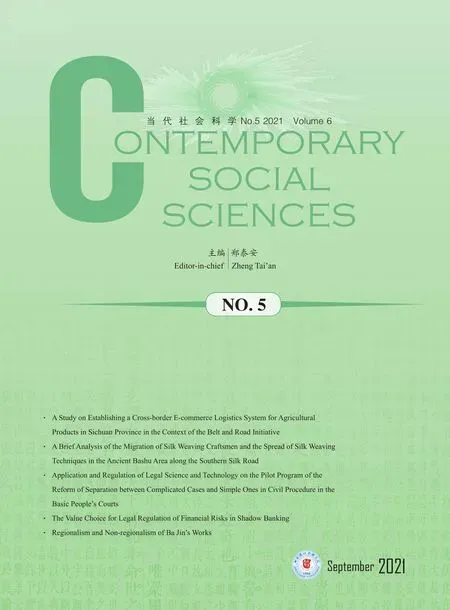 Contemporary Social Sciences2021年5期
Contemporary Social Sciences2021年5期
- Contemporary Social Sciences的其它文章
- 《当代社会科学(英文)》稿件格式参考Manuscript Format
- Research and Analysis on the Origin of the Term “Xinche” in Traditional Chinese Medicine and Its Translation
- A Study of the Pit-Aided Construction of Egyptian Pyramids
- The Significance of Inter-Cultural Communication of “Panda Fever”— A Case Study of “Meng Meng” and “Jiao Qing” in Berlin
- Application and Regulation of Legal Science and Technology on the Pilot Program of the Reform of Separation between Complicated Cases and Simple Ones in Civil Procedure in the Basic People’s Courts
- Review of Environmental Governance Research since the 18th CPC National Congress— Based on Bibliometric Analysis
